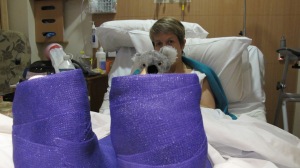(Scroll to bottom for beginning of narrative: Finding my Feet)
I have been told ‘No’ for many years with regard to my feet: No, it’s not possible to operate; No, we don’t know the origins of your problem feet; No, you will just have to live with them.
So when I heard ‘Yes’ for the first time, I got excited.
I was sitting across from a respected orthopaedic surgeon and he was telling me there was a solution. And it could be done in the next few weeks!
As he quizzed me on how my feet were bothering me (in a manner that felt like interrogation), he seemed to gravitate to a single element in my list of symptoms: the fact that I went over on my ankles. From that point, he became energised, describing how that problem could be corrected, improving my condition by up to 90 per cent. 90 per cent improvement! I could barely contain my emotions.
But there were things he was saying – and not saying – that were giving me a sense of disquiet. So I quizzed him.
Could we reduce my high arches? No, my pes cavus could not be fixed by surgery.
But I’ve read about a woman in the US who had her high arches successfully corrected. We can’t do it.
What about my hammer toes – could they be straightened? Well yes, but not with this operation.
Why not? It would be too risky in concert with the other procedure to stabilise my ankles. Yes, my toes would inevitably get worse, but we could wait for a few years when they we were in poorer shape and then perform a second operation to correct them at that time. (He advised me to take a photo of my hammer toes now and then take another photo in a year to track their inevitable worsening).
Well, what about being able to wear different shoes – ones that were more attractive and wouldn’t bother my feet? Sorry, you’re just going to have to buy orthopaedic shoes. (He didn’t actually appear that sorry at all; his manner evidenced little in the way of empathy.)
So the news wasn’t that good after all.
In addition, I would have to have two surgeries – each foot to be done separately – thus requiring double the time off work and double the cost of the procedure and hospitalisation fees. Not to mention the two subsequent surgeries for my clawed toes in the future!
Should I get a second opinion? If you want to, you can. But, if he’s any good, he’ll tell you the same thing.
And then the surgeon swiftly consulted his diary, tentatively booked me in for a date six weeks in the future, gave me some literature on post-op treatment, and the bill estimate. And then he said goodbye.
I quizzed the receptionist on my way out. Is he a skilled practitioner? Are his skills as a surgeon better than his bed-side manner? Oh yes, I wouldn’t work for him if he wasn’t any good!
I am so glad I trusted my instinct and listened to neither of them. I shudder to think what would have happened if I hadn’t decided to seek a second opinion. What if I was one of those people who categorically believe everything the authority in the white coat tells them? It makes me angry that there are likely others with CMT (Charcot Marie Tooth disease) and pes cavus feet that have listened to this surgeon, and others like him, and not had their actual problem addressed.
The surgeon, who shall remain nameless, specialises in sports injury and in ligamentous stabilisation of the ankle. Remarkably, this is the same procedure he recommended for me along with osteotomy with internal fixation of various bones. Because of his arrogance and lack of interest in a condition that fell outside of his sphere of specialisation, he was willing to give me a stop-gap solution. How selfish!
I am so grateful for a little thing called the Internet that led my husband to find Drs Ellis, Warren and Nicholson who were the right people to help me with my condition. I am also grateful that I listened to others who cautioned me against surgeons who are more interested in collecting their fee than the central interests of the person sitting in front of them. Had I not listened to those other opinions, and had I been swept up by the excitement of a possible solution, I may have embarked on a series of costly procedures that would have ultimately impaired the functioning of my feet.

